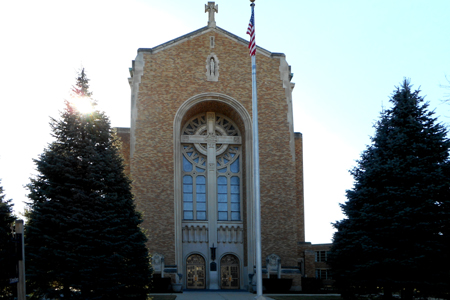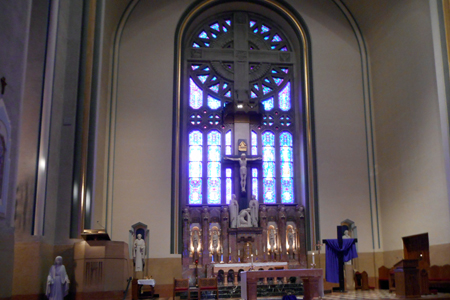| |
 |
 |
 |
| Comment on this report, or find other reports. |
 |
| Our Mystery Worshippers are volunteers who warm church pews for us around the world. If you'd like to become a Mystery Worshipper, start here. |
 |
| Find out how to reproduce this report in your church magazine or website. |
|
|
| 3127: St Joseph's, Wilmette, Illinois, USA |
 |
 |
 |
Mystery Worshipper: Paterfamilias.
The church: St Joseph's, Wilmette, Illinois, USA.
Denomination: Roman Catholic, Archdiocese of Chicago.
The building: The parish is one of the oldest in the Chicago area, with the first pastor arriving by stagecoach in 1845 to celebrate mass in a chapel that was little more than a log cabin. A larger church was built five years later, and one larger still in 1869. The present building dates from 1939 and involves an interesting tale, which I'll get to shortly. It is the work of Joseph William McCarthy, one of the most distinguished 20th century architects in the Chicago area, who designed several churches for the Archdiocese of Chicago. McCarthy liked to combine Art Deco elements with more traditional aspects of medieval architecture. There is a tall, narrow nave with stained glass windows, alternately featuring striking reds and blues. There are quite large Stations of the Cross. Against the east wall, the reds and browns of the reredos stand in contrast to the bright blue of the stained glass window above it. We are constantly reminded that we worship with "all the host of heaven," with the women at the tomb at the foot of the cross, and stylized, elongated angels flanking the four evangelists. The choir and organ are in a rear balcony. And now for the story behind it: In 1872, a priest named William Netstraeter arrived from Germany to assume the duties of pastor of what was essentially at the time a German-speaking parish. He would stay for the next 52 years! Father Netstraeter drew no salary, but dabbled in real estate as a hobby. When he died in 1923, he left the parish some $300,000 with the stipulation that it be used for the design and construction of a new church. However, Joseph Cardinal Mundelein, Archbishop of Chicago, somehow never got around to approving the project – and then the Great Depression hit! At the same time, Adolf Hitler began his rise to power in Germany. In 1937, Cardinal Mundelein, who was of German ancestry, gave a speech denouncing Hitler in scathing terms, calling him a "mere paper hanger, and not a very good one at that." The speech was picked up by the international press, which made Hitler an object of ridicule. Hitler, to take revenge on the Cardinal Archbishop, sent agents to Chicago to try to dig up some scandal. They managed to locate relatives of Father Netstraeter and had them sue the Cardinal Archbishop in US courts for not building the church called for in the late pastor's will. The lawsuit was thrown out of court, but when the Vatican got wind of it, they strongly suggested to Cardinal Mundelein that he build the church. And build it he did, with Father Netstraeter's legacy augmented by the sale of bonds arranged by the new pastor. Cardinal Mundelein consecrated the church in late September of 1939 – and died a few days later!
The church: There are five weekend masses and two each weekday. Eucharistic adoration is held every other Tuesday, and Stations of the Cross every Friday evening in Lent. There are men's and women's groups, and several activities intending to bring back to the church those who have fallen away. There is a school and convent; the school was closed for some ten years beginning in the 1980s, shortly after the Sisters of St Francis ceased their work in the parish. But the Sisters of Christian Charity moved into the convent in 1997 and organized preschool and elementary school classes (to Grade 8).
The neighborhood: Wilmette is a small village just north of Chicago that serves primarily as a bedroom community. It is well served by public transportation, including a commuter railroad and the Chicago Transit Authority's "L" trains. The village is noted for a well-developed urban forest containing over 150 species and subspecies of trees. Wilmette is the site of the Bahá'í House of Worship, the oldest surviving Bahá'í temple in the world and the only one in the United States. There are also several well-preserved private residences of historical interest. There is a small commercial district across the street from the church, but the parish is largely surrounded by single family residences.
The cast: There was no service leaflet, so I cannot be sure. I believe, though, that the Revd Matt Bozovsky, associate pastor, was celebrant and preached. He was assisted by a deacon, who may have been the Revd Mr D.J. Skinkle.
The date & time: Second Sunday in Lent, March 12, 2017, 10.15am.
What was the name of the service?
Mass.
How full was the building?
I will guess that the building holds 800. People continued to arrive up until the reading of the gospel. By then, it was close to half full.
Did anyone welcome you personally?
Yes. There were two ushers who handed me a bulletin.
Was your pew comfortable?
Comfortable enough.
How would you describe the pre-service
atmosphere?
Quiet and prayerful.
What were the exact opening words of the
service?
"Good morning and welcome to St Joseph Parish," from the cantor.
What books did the congregation use during the
service?
The paperback hymnal/missal Breaking Bread, published by Oregon Catholic Press. Copies of the New American Bible were in the pews but not used.
What musical instruments were played?
A two-manual, 24-rank pipe organ, reconfigured, rebuilt and revoiced in 2010 by Berghaus Pipe Organ Builders, Inc. of Bellwood, Illinois. Also an electronic keyboard (more of the latter than the former).
Did anything distract you?
The quite large number of congregants who continued to enter through the opening of mass and the first two readings.

Was the worship stiff-upper-lip, happy clappy, or
what?
Pretty much a normal suburban Catholic mass in North America. All of the music was in a contemporary"pop" style. Sharing of the peace was restrained, and there was certainly no "happy talk."
Exactly how long was the sermon?
7 minutes.
On a scale of 1-10, how good was the preacher?
8 – The associate pastor is a very effective public speaker.
In a nutshell, what was the sermon
about?
He noted that he had visited a friend of his, a priest, and they had hiked in the Smoky Mountains. They climbed to a lookout, and from higher ground he had quite a different perspective, one he doesn't get often in the Midwest. Peter, James and John (the gospel was of the Transfiguration) saw a different perspective after climbing the mountain with Jesus. Previously, God's glory and power remained hidden. The disciples experienced Jesus' divinity. We need in this Lent to experience our weakness and dependence on God, the better to understand the fullness of his glory.
Which part of the service was like being in
heaven?
Seeing architect Joseph William McCarthy's striking design for the first time.
And which part was like being in... er... the other place?
The parish does not seem to see music as an important support for Catholic worship. Cantor and organist are both accomplished musicians, but basically no more of the service was sung than had to be. Opening and closing hymns were limited to one verse, and there was no way for a visitor to know what service music was being sung (I did not recognize any of it). Three hymns were posted on the hymn board, but one of those was in error.
What happened when you hung around after the service looking lost?
Nothing. St Joseph has three masses on Sunday mornings literally scheduled back to back; one congregation left as another was beginning to come in.
How would you describe the after-service
coffee?
There was none.
How would you feel about making this church your regular (where 10 = ecstatic, 0 = terminal)?
4 – Materfamilias and I would need a more vibrant music program in our parish home. And there are so many options in the Chicago area.
Did the service make you feel glad to be a
Christian?
Yes.
What one thing will you remember about all this in seven days' time?
The beautiful architecture of this space.
|
|
|
 |
 |
 |
| We rely on voluntary donations to stay online. If you're a regular visitor to Ship of Fools, please consider supporting us. |
 |
 |
 |
| The Mystery Pilgrim |
 |
| One of our most seasoned reporters makes the Camino pilgrimage to Santiago de Compostela in Spain. Read here. |
 |
 |
 |
| London churches |
 |
| Read reports from 70 London churches, visited by a small army of Mystery Worshippers on one single Sunday. Read here. |
| |
|
|
|
|


